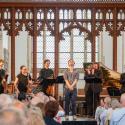The Takács Quartet is hard to pin down. The group was founded in 1975 in Budapest, but since 1983 has been based in Boulder, Colorado. Cellist András Fejér is the only remaining founding member, and the violist, Richard O’Neill, only joined in 2020. They also have a British first violin, Edward Dusinberre. So what performing tradition can we expect from them?
Well, the sound is impressively unified, but it is not very sonorous or rich, at least on this showing. They have an impressively diverse repertoire, and regularly work with contemporary American composers. This programme was more traditional – Haydn, Janáček, Beethoven – but each piece was distinctive, suggesting a wide variety of performing influences.
Haydn’s F-Minor String Quartet, Op. 20 No. 5, is a relatively early work (1772), but is forward looking in its textures and harmonies. The Takács approach was to articulate the music in long, flowing phrases, over lighter and more delicate accompaniments. Tempos were brisk and quite strict, with a classical-era discipline against which the lyrical melodic lines could push. The faster outer movements revealed some intonation problems, including a slip in the final chord of the first movement. The fugal finale was taken particularly fast, and Dusinberre struggled to tune a few of the entries. But the overall effect was of a bracing palate cleanser ahead of the more substantial works ahead.
 Janáček’s Second Quartet, "Intimate Letters" (the composer, pictured left), has become a repertoire work, but the Takács players reminded us just what a strange and otherworldly piece it is. Their performance was filled with jarring contrasts. The first happens almost immediately, when the forceful opening gesture is interrupted by a quiet, slow viola monologue, the atmosphere perfectly captured by O’Neill. Other performers have shown that the sudden crescendos and texture changes can be integrated into a more normal and coherent musical discourse, but the Takács players go in the opposite direction, highlighting every discontinuity. It works, largely for the sheer determination with which they launch into each new phrase, but also the tonal control they bring to the quiet passages, especially the glassy harmonic textures high up in the viola and cello.
Janáček’s Second Quartet, "Intimate Letters" (the composer, pictured left), has become a repertoire work, but the Takács players reminded us just what a strange and otherworldly piece it is. Their performance was filled with jarring contrasts. The first happens almost immediately, when the forceful opening gesture is interrupted by a quiet, slow viola monologue, the atmosphere perfectly captured by O’Neill. Other performers have shown that the sudden crescendos and texture changes can be integrated into a more normal and coherent musical discourse, but the Takács players go in the opposite direction, highlighting every discontinuity. It works, largely for the sheer determination with which they launch into each new phrase, but also the tonal control they bring to the quiet passages, especially the glassy harmonic textures high up in the viola and cello.
Beethoven’s 15th String Quartet, Op. 132, is another radical work, but this time the Takács players took a more measured approach, emphasising the lyricism and focusing their attentions on contrapuntal clarity. The lack of weight in their sound deprived the music of some of its breadth and symphonic scope, but the more matter-of-fact approach let the music speak for itself. That was particularly beneficial to the "Heiliger Dankgesang" third movement, here performed with minimal vibrato and solid tone, despite the low dynamic. The quartet’s ability to sustain long, even phrases was of greater benefit here than in the Haydn, and the louder central section contrasted effectively without need for dynamic excess.
In the Alla marcia fourth movement, the players attempted to articulate the opening phrases by exaggerating the silences between. But, again, the pressure that placed on their intonation spoilt the effect. Better was the last movement, which Beethoven marks Allegro appassionato, but which the Takács players delivered cleanly and precisely. There was drama here, but no histrionics, with the music’s advanced harmonic structure complementing the elegant and well-balanced lines. Perhaps the ending did reach the Presto tempo that Beethoven prescribes, but with playing of this precision and refinement it still felt measured. The Takács Quartet show that Beethoven can still be exciting and unpredictable, even when they keep everything under tight control.














Add comment